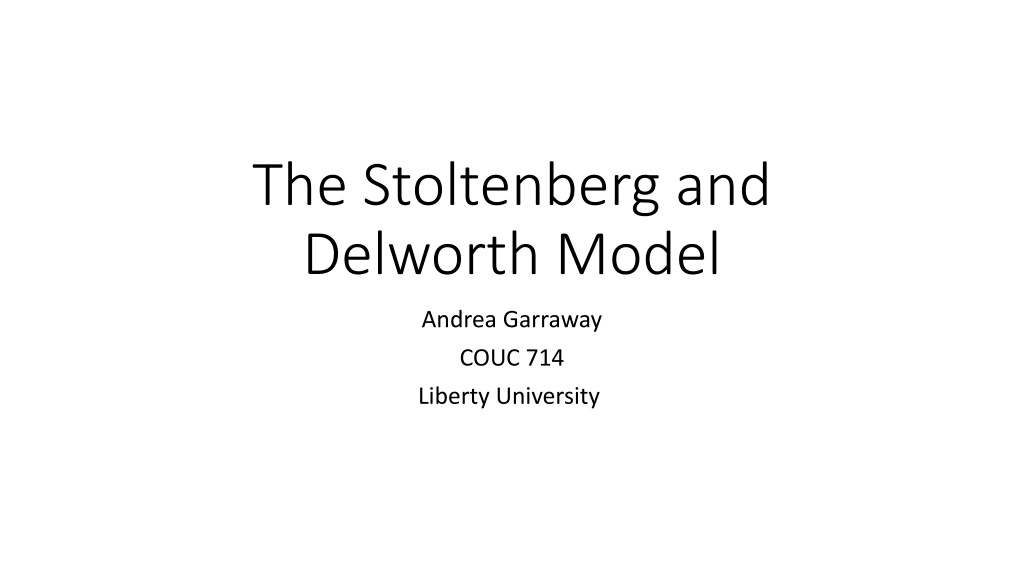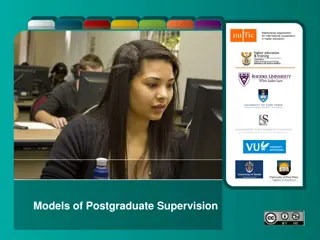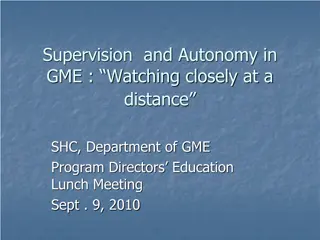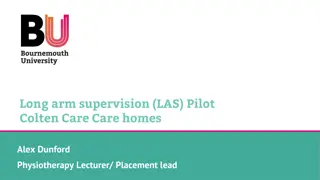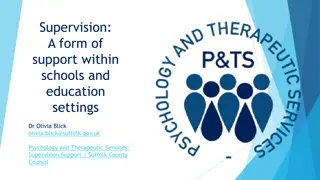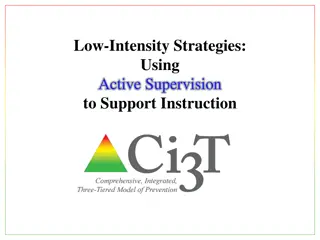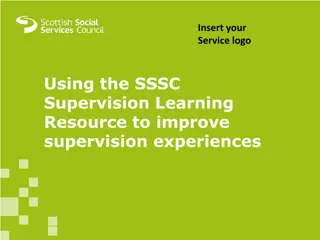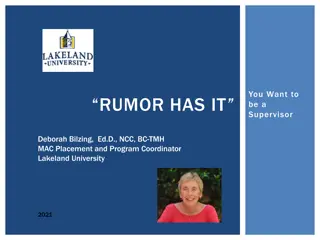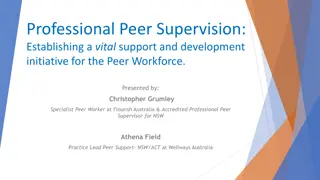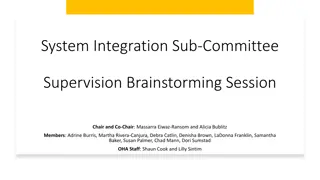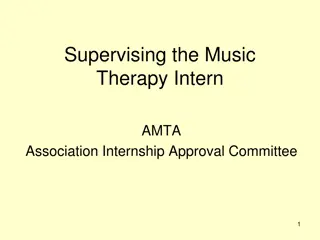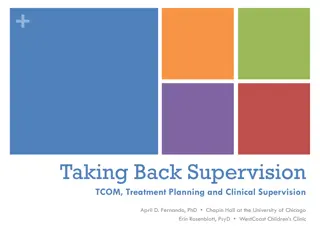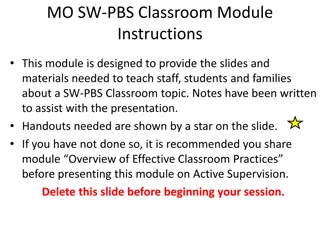Comprehensive Overview of Stoltenberg and Delworth Model in Clinical Supervision
The Stoltenberg and Delworth model in clinical supervision aims to enhance supervisory competence by identifying personal supervisory orientations. It emphasizes individualized learning plans for supervisees to maximize growth and lifelong learning. There are 16 counselor-supervisee developmental models drawing from various theories. This model offers a guide for assessing trainees, intervening to improve client sessions, and addressing challenges at different supervisee levels.
- Clinical supervision
- Stoltenberg and Delworth model
- Developmental models
- Counselor-supervisee
- Supervisory competence
Download Presentation

Please find below an Image/Link to download the presentation.
The content on the website is provided AS IS for your information and personal use only. It may not be sold, licensed, or shared on other websites without obtaining consent from the author. Download presentation by click this link. If you encounter any issues during the download, it is possible that the publisher has removed the file from their server.
E N D
Presentation Transcript
The Stoltenberg and Delworth Model Andrea Garraway COUC 714 Liberty University
The goal is to enhance the foundation of supervisory competence Summarize The Stoltenberg and Delworth model Elevate our theoretical knowledge base and encourage the pursue further investigate in order to identify personal supervisory orientation. Learning objectives
Developmental model Clinical supervision is the construction of individualized learning plans for supervisees working with clients. The object of the developmental model is to identify new areas of growth and maximize the need for the life-long learning process. Developmental models of supervision define progressive stages of supervisee development from novice to expert. This evolutionary process, appeared to be of a scientific basis, as studies revealed both the behavior of supervisors and supervisees are growing as experiences are gained. (Bernard & Goodyear, 2013)
There are 16 counselorsupervisee developmental models. Example: (Loganbill et al. s (1982) Developmental model (Loganbill et al. s (1982) Stoltenberg McNeill, 2010 Stoltenberg McNeill, 2010 Integrative developmental model (Stoltenberg & McNeill, 2010) Rigazio-DiGilio, Daniels, Ivey, 1997 Systemic cognitive developmental supervision model (Rigazio- Rigazio-DiGilio, Daniels, Ivey, 1997 DiGilio, Daniels, & Ivey, 1997) Reflective developmental models Lifespan developmental models. Historical data Some draw heavily on psychosocial developmental theory which includes: Cognitive learning theory Interpersonal influence Social learning Motivation theory Models of human development
offers a comprehensive guide to supervising counselors and therapists in training called supervisees. The method (1) explain the needs and characteristics of trainees at each level; (2) outline procedures for assessing trainees in eight areas of growth, including interpersonal skills, treatment goals, and client evaluation; and (3) recommend how and when supervisors may intervene to help trainees handle sessions with clients. Stoltenberg and Delworth (1987) (Bernard & Goodyear, 2013)
Level 2 supervisees are at mid-level and experience fluctuating confidence and motivation, often linking their own mood to success with clients. Level-1 Experiences high levels of anxiety. Three levels of supervisees Level 3 supervisees are essentially secure, stable in motivation, have accurate empathy tempered by objectivity, and use therapeutic self in intervention. (Bernard & Goodyear, 2013; Stoltenberg, 1981)
Three supervisee stages(1-3) Lvl 1_Beginning_ Stagnation Stage. Dependent (diagnose clients and establish plans for therapy), rigid, shallow, cognitively simple, black- and-white thinking and to lack insight into on impact on the supervisor or client. He or she also may experience counseling as uninteresting or dull (or stuckness ) or as a blind spot concerning, neutrality or unawareness. (Bernard & Goodyear, 2013)
Three supervisee stages (2-3) Lvl 2_Intermediate_ Confusion Stage. Resistance, easily threatened, avoidance, instability, disorganization, erratic fluctuations, disturbance, chafe at suggestions, confusion, and feeling conflicted. The perception that the supervisor is withholding information or incompetent would result in anger or frustration. Feelings liberation from a rigid belief system and from traditional ways of viewing the self and behaving toward others is also key here. This can be troubling, because the supervisee realizes that something is wrong, but does not yet see how it will be resolved. (Bernard & Goodyear, 2013; Stoltenberg, McNeill, & Delworth, 1998)
Three supervisee stages (3-3) Lvl 3_Advanced_ Integration Stage. Function independently, seek consultation when appropriate, realistic about strengths and weaknesses, and feel responsible for their correct and incorrect decisions. A new cognitive understanding, flexibility, personal security based on awareness of insecurity and an ongoing continual monitoring of the important issues of supervision Time and expertise expectations remain consistent (Bernard & Goodyear, 2013; Stoltenberg, McNeill, & Delworth, 1998)
SelfOther Awareness: Cognitive and Affective [W]here the person is in terms of self-preoccupation, awareness of the client s world, and enlightened self-awareness. The cognitive component describes the content of the thought processes characteristic across levels, and the affective component accounts for changes in emotions such as anxiety. Three markers in assessing professional growth Motivation [R]eflects the supervisee s interest, investment, and effort expended in clinical training and practice. Autonomy Reflects the degree of independence that the supervisee is manifesting. (Bernard & Goodyear, 2013; Stoltenberg & McNeill, 2010)
Level 1. These supervisees have limited training, or at least limited experience in the specific domain in which they are being supervised. Motivation: Both motivation and anxiety are high; focused on acquiring skills. Want to know the correct or best approach with clients. Autonomy: Dependent on supervisor. Needs structure, positive feedback, and little direct confrontation. Awareness: High self-focus, but with limited self-awareness; apprehensive about evaluation. Level 2. Supervisees at this level are making the transition from being highly dependent, imitative, and unaware in responding to a highly structured, supportive, and largely instructional supervisory environment (p. 64); usually after two to three semesters of practicum. Motivation: Fluctuating, as the supervisee vacillates between being very confident to unconfident and confused. Autonomy: Although functioning more independently, he or she experiences conflict between autonomy and dependency, much as an adolescent does. This can manifest as pronounced resistance to the supervisor. Awareness: Greater ability to focus on and empathize with client. However, balance still is an issue. In this case, the problem can be veering into confusion and enmeshment with the client. Stoltenberg et al. note that this can be a turbulent stage and supervision of the Level 2 therapist . . . [requires] considerable skill, flexibility, and perhaps a sense of humor (p. 87). Level 3. Supervisees at this level are focusing more on a personalized approach to practice and on using and understanding of self in therapy. Motivation. Consistent; occasional doubts about one s effectiveness will occur, but without being immobilizing. Autonomy: A solid belief in one s own professional judgment has developed as the supervisee moves into independent practice. Supervision tends to be collegial as differences between supervisor and supervisee expertise diminish. Awareness: The supervisees return to being self-aware, but with a very different quality than at level 1. Supervisees at this level are able to remain focused on the client while also stepping back to attend to their own personal reactions to the client, and then to use this in decision making about the client. Level 3i (Integrated). This level occurs as the supervisee reaches level 3 across multiple domains (e.g., treatment, assessment, conceptualization). The supervisee s task is one of integrating across domains. It is characterized by a personalized approach to professional practice across domains and the ability to move easily across them. This supervisee has strong awareness of his or her strengths and weaknesses. Bernard & Goodyear, 2013
Supervisee Characteristics and Supervisor Behavior Exercise
Intervention skills competenceconfidence and ability to carry out therapeutic interventions Assessment techniques confidence and ability to conduct psychological assessments Interpersonal assessment extends beyond the formal assessment period and includes the use of self in conceptualizing client problems; its nature varies according to theoretical orientation Client conceptualization diagnosis, but also pertains to the therapist s understanding of how the client s circumstances, history, and characteristics affect his or her functioning Individual differences an understanding of ethnic and cultural influences on individuals Theoretical orientation pertains to the level of complexity and sophistication of the therapist s understanding of theory Treatment plans and goals how the therapist plans to organize his or her efforts in working with clients Professional ethics how professional ethics intertwine with personal ethics Growth Areas (8) Bernard & Goodyear, 2013
Drawbacks Focuses predominantly on the development of graduate students in training, with little application to post-degree supervision. There are limited suggestions for specific supervision methods that are applicable at each supervisee level.
Within each level the authors noted a trend to begin in a rigid, shallow, imitative way and move toward more competence, self-assurance, and self-reliance for each level. This model presents a clear and flexible conceptual model of the developmental approach to supervision. Recap As the supervisee approaches mastery at each stage, the supervisor gradually moves the scaffold to incorporate knowledge and skills from the next advanced stage. Bernard & Goodyear, 2013
Reference Bernard, J. M., & Goodyear, R. K. (2013). Fundamentals of clinical supervision (5thed.) Boston, MA: Allyn & Bacon. Stoltenberg, C. D. (1981). Approaching supervision from a developmental perspective: The counselor complexity model. Journal of Counseling Psychology, 28, 59-65. Stoltenberg, C. D., & Delworth, U. (1987). Supervising counselors and therapists. San Francisco, CA: Jossey-Bass. Stoltenberg, C. D., McNeill, B., & Delworth, U. (1998). IDM supervision: An integrated developmental model for supervising counselors and therapists. San Francisco, CA: Jossey-Bass.
